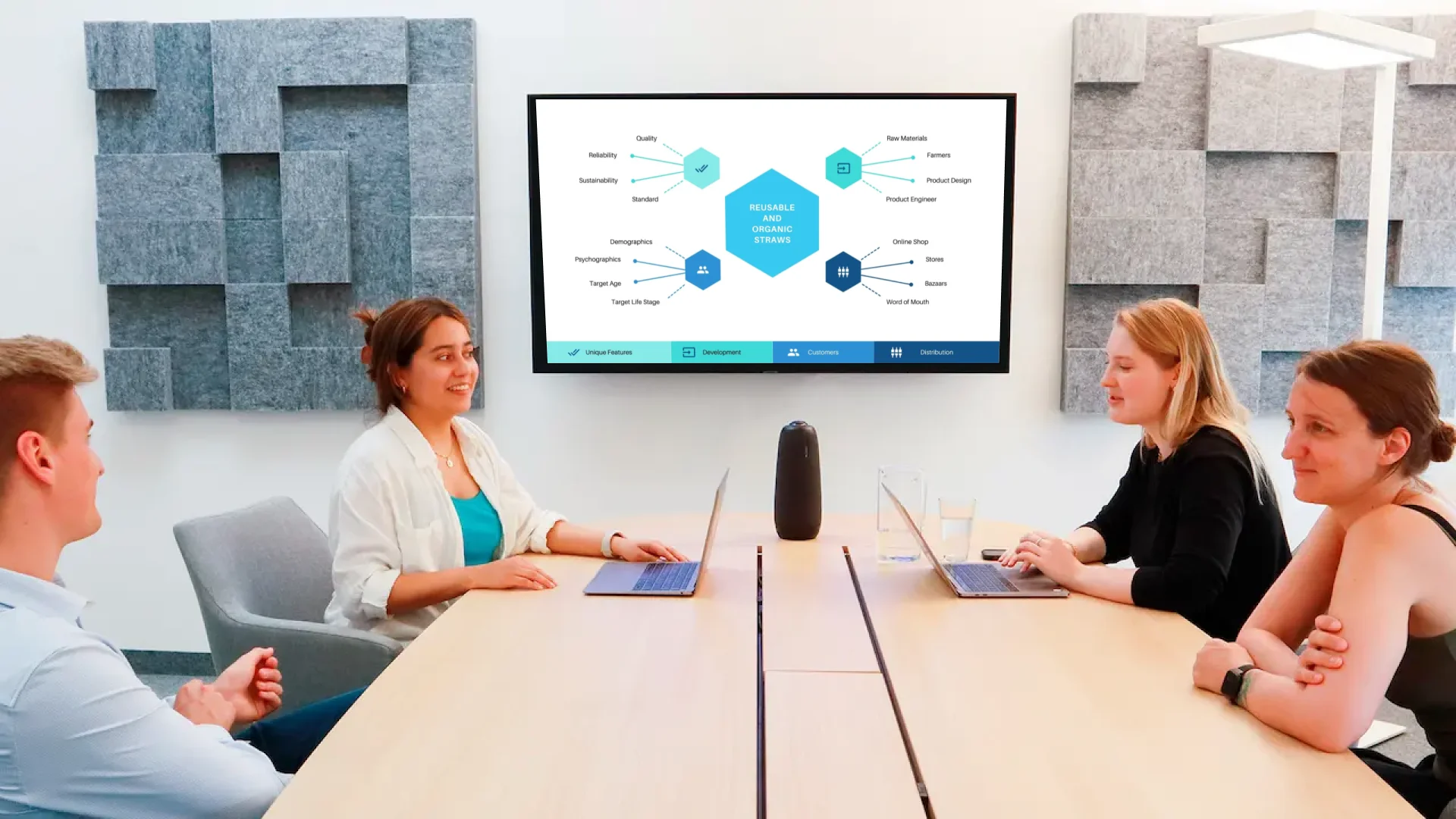
Dec 8 2023
8 min read


Mar
The winds of advancements in computing and telecommunications that began flowing in the 20th century have metamorphosed today into an all-pervading digital hurricane. The meteoric emergence of digital technologies, such as artificial intelligence, cloud computing, and the Internet of Things, has ushered in an era of express communication, enhanced convenience, and global collaboration.
The digital signage segment that emerged as an outcome of this revolution promises to be the next big thing. The dazzling digital displays dotting the Times Square high-rises and vying for viewers’ attention offered many their first brush with the world of digital billboards and signage.
After redefining the cityscapes of New York and its metropolis kin, digital signage systems are now on course to transform modern offices. Convinced by their many use cases and merits, businesses of all sizes have begun incorporating digital signage in their workplaces.
This blog explores how various applications and benefits of digital signage enable companies to reinvent their workplaces and culture.
“It takes 100 good impressions to compensate for one bad one.”
“You only get one chance to make a last impression.”
Brand experts, dating gurus, and image consultants love to throw around such clichés. Notwithstanding the casualty of statistics and science in these aphorisms, their underlying essence is loud, clear, and undisputed: first impressions matter.
When an outsider walks into an office not knowing what to expect, the lobby offers the first peep into the company; its visuals and aura set their expectations from the business. The foyer represents employees’ first and last interaction with the office daily.
Organizations can exploit the dynamic nature of digital screens and video walls to exhibit the company’s philosophy, values, and culture. Digital displays in the lobby can showcase to the outside world the brand’s growth story, its myriad achievements, a glimpse into its array of products and services, and testimonials from stakeholders.
When Salesforce, the world’s biggest enterprise software undertaking, unveiled the digital signage experience in its San Francisco office lobby, it made enormous waves, not just in press and corporate circles, but on a 106-foot, seven-million-pixel LED screen, too. The display boards transformed the lobby into snowy mountains one day and a Pac-Man universe on another.
From displaying a simple welcome message on a small screen to fabricating a verdant forest in the entryway of an office in the middle of an arid desert, digital display boards for offices offers brands limitless opportunities.
Thanks to the great strides made over millennia, we now live in a world where communicating is a nonlethal activity that takes just a few clicks, not marathons and lives. But ease of communication hasn’t exactly translated into better corporate communication.
An Employee Job Satisfaction and Engagement Survey Employee Job Satisfaction and Engagement Survey by the Society for Human Resource Management (SHRM) concludes that 47% of employees are unsatisfied with communication between employees and management.
Office digital signage has emerged as a preferred mode of open communication between businesses and employees. By informing employees about the company’s goals, values, strategies, and long-term vision, digital displays keep everyone aligned with the big picture.
A robust content management strategy is crucial to maximize the potential of office digital signage. Consider implementing a digital signage content management system (CMS) that allows for easy updates, scheduling, and integration with existing data sources. By streamlining the content management process, companies can ensure their digital signage remains a dynamic and relevant tool for communication and engagement.
Digital display boards in offices can also simplify global internal comms by intelligent scheduling of messages based on office time zones. This digital tool can also remove language barriers and cater for a more diverse workforce.

The key to achieving long-term success is focusing on short-term goals and challenges. As legendary management consultant Peter Drucker remarked, only what gets measured gets managed.
Organizations can harness digital office displays to share their goals, mission, and vision.The digital sign software platforms can be integrated with the company business tools empowers offices to bring real time information on screen, such as:
KPI metrics
CRM data
Sales & marketing dashboards
Meeting room booking information (for coworking spaces)
Project management dashboards, etc.
Unlike lengthy text-rich emails and monotonous PowerPoint presentations in meeting rooms, resplendent displays of monthly dashboards and quarterly performance trackers on workplace digital signage are inarguably more comprehensible, engrossing, and interactive.

While 94% of organizations believe that recognizing the performance of employees improves their performance, only 56% of American employees are satisfied with management’s recognition of their performance.
Recognizing the achievements of workers on office digital signage is an effective way of boosting their morale and reinforcing positive behavior. A picture is worth a thousand words: team members are likelier to notice and appreciate a colleague’s accomplishment when they see a beaming face on a visually-appealing digital display rather than a footnote in a text-heavy email.
Digital signage software platforms like Pickcel offer tons of apps like People Space, Meet Your Team to highlight employee profiles & achievements.
When offices recognize employee performance in such a grand manner, it incentivize them to work efficiently in a healthy competitive environment.

The learning and development (L&D) domain forms the crux of the growth model of any organization. While conventional L&D models work best when skilling programs require rigorous training, technical understanding, or long-term commitment, new-age workspace digital display board systems effectively educate employees on best practices, compliance regulations, and safety protocols.
An individual contributor transitioning into a managerial role must undergo days-long L&D session to equip themself with the necessary skills and technologies for the new position.
However, now, with more and more businesses are incorporating microlearning practices in their development models, the adoption of office digital signage is bound to gather pace.
The unparalleled fluidity of digital signage platforms – the ability to switch between videos, animations, graphs, GIFs, images, and text – makes them more effective in facilitating information retention than traditional models, such as emails and town-hall seminars.

Most new-ages businesses recognize their role in the health and well-being of employees. Not every company has the wherewithal to offer on-site health amenities like gyms, massage rooms, and meditation rooms. Office digital signage, however, has democratized, to a large extent, the ability of businesses to implement health and wellness programs at the workplace.
Using digital menu board solutions in office cafeterias has immense advantages. Providing a breakdown of nutrients in food options allows employees to choose healthier and sustainable diet options.
Strategically deployed digital office displays can periodically nudge employees to practice ergonomic principles, stay well-hydrated, and take time-outs to rest their eyes and walks to stretch their bodies.
Strategic placement of digital signage can significantly enhance its impact within an office environment as well. To optimize placement, companies should conduct thorough site surveys to identify high-traffic areas that capture maximum employee attention, such as break rooms, main entrances, or elevator banks. Additionally, digital displays should be positioned at eye level to facilitate easy viewing, and consider ambient lighting conditions to reduce glare and enhance readability.
An attention-grabbing video or a colorful image in the right spot can do more to help improve employees’ mental health than a text-heavy health missive drowned amid a bouquet of work emails.
The versatility of digital signage platforms makes them a fertile ground for creativity and imagination. They are a marketer’s delight; their multimedia screens allow the deployment of rotating graphics, video advertisements, static advertisements, flashy animations, product demonstrations, and simple text-based calls to action.
Organizations can explore beyond just hosting promotions of in-house products, services, training sessions, conferences, and events.
Often, tie-ups and collaborations with other organizations entitle employees to avail of specially curated offers and deals. Digital office displays can narrowcast such short-term promotions and help employees make the most of them.
Companies can also rent their digital office displays to other non-competing companies to generate additional revenue.
Ensuring the safety of employees is a critical part of workplace management. Most offices have safety programs, such as conducting regular risk assessments, forming a safety plan, training employees, and maintaining protective equipment and medical kits, is as critical as communicating these safety guidelines and practices to employees.
Emails and newsletters on safety and emergency will likely remain buried in the sea of work-related emails. Even if employees consume the vital information shared through such bulletins, they may not realistically recall the minutiae of the standard safety protocol when an emergency strikes.
In an emergency, the capacity to swiftly alert the entire staff is paramount. The rescue of 2700 Morgan Stanley employees in the World Trade Center during the 911 terrorist attacks by American security specialist Rick Rescorla underscores the importance of adequate alerting mechanisms and qualified safety marshals.
The potential of digital display systems to show real-time messaging can ensure fast dissemination of alerts, flashing of security protocols, emergency helplines, and more. Further, office digital signage solutions can be integrated with Integrated Public Alert and Warning System (IPAWS) to adhere to a uniform Common Alerting Protocol (CAP).
Imagine you are scheduled to be interviewed for your dream job at a company whose office you have never visited before. You reach the campus just in time, only to notice the campus has several multi-story buildings spread across a vast area. You ask for directions to the interview room; some are entirely clueless, while others point you in the wrong direction. Not finding a way to your destination quickly makes you even more anxious and helpless.
Most of us have had such experiences. The absence of wayfinding and directories can turn what should be an exciting visit to an office complex into an agonizing ordeal. It gets even more tormenting for individuals with a reclusive personality or psychological disability.
Many businesses install printed maps to help people find their way. But they have several drawbacks: they offer static, standardized assistance to users, and any change to directories and guidelines necessitates their republication.
Electronic wayfinding systems on digital office displays, on the contrary, allow businesses to revise maps and directories remotely in real time.
Given their responsiveness, versatility, and ability to interact with users, including those with impairments, disabilities, and mental health issues, the transition from paper and ink to glittering pixels has only accelerated.
Nothing captures the essence of the business world better than the Greek philosopher Heraclitus’ quote: the only constant in life is change. Businesses, even the world’s biggest or monopolies, cannot afford to remain immutable to technological progress and disruptions. They must keep reinventing themselves by transforming their systems and cultures to retain their competitive edge in these times of interminable disruptions.
Technological advancements turned typewriters, calculators, and rolodexes, which were intrinsic aspects of a 20th-century workplace, redundant and made businesses adopt digital modes of communication. The rapid adoption of digital display boards in offices heralds the next frontier for modern workplaces.
The unparalleled versatility of office digital signage allows businesses to use them in various forms in their workplaces, such as interactive screens, video walls, and menu boards. From sharing regular updates and announcements with employees to showcasing company culture and advertising offerings to external stakeholders, digital displays offer various use cases to organizations.
While the benefits of digital signage are considerable, it is worth noting that careful budget planning is essential to ensure a cost-effective implementation. Companies should start by defining the scope and objectives of their digital signage project to estimate initial costs accurately. This includes hardware expenses like screens and media players, software for content management, installation fees, and ongoing maintenance. To mitigate costs, businesses could explore leasing options or look for vendors that offer scalable solutions with flexible payment terms. Additionally, evaluating the return on investment by measuring improvements in employee productivity and engagement can help justify the expenditure.
By harnessing the multimedia capabilities of digital display board systems, businesses can communicate transparently with workers, enhance their productivity, nurture an atmosphere of safety and positivity, and, therefore, achieve exceptional growth and success.
Take complete control of what you show on your digital signage & how you show it.
Start Free Trial Schedule My Demo
Dec 8 2023
8 min read

Nov 24 2023
5 min read

Nov 17 2023
7 min read

Sep 12 2023
8 min read